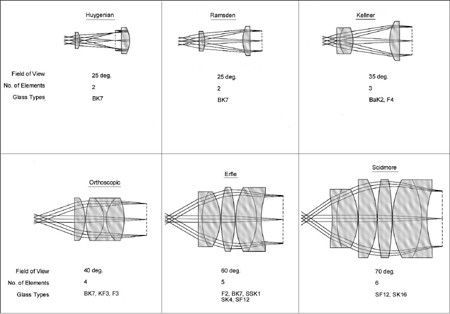Optipedia • SPIE Press books opened for your reference.
Explanation of eyepieces from SPIE Press
Excerpt from Optical Engineering Fundamentals, Second Edition
The eyepiece is quite similar in function to the magnifier. It differs primarily in that the eyepiece is generally used in conjunction with other optics to form a complete instrument, such as a telescope or microscope. In that type of application, the eyepiece serves two functions simultaneously: first, it must project the final image to the viewer's eye, and second, it must form an image of the system aperture stop, which will be the exit pupil of that instrument. While the first function is by far the most important, proper eyepiece design requires that the second be paid some attention.
Eyepieces are generally more complex than the simple magnifier, and they become increasingly more complex as the field of view that must be covered is increased. That complexity is reflected in the number of elements that are required and the glass types that are used in the design. Figure 8.6 illustrates this point, presenting general information on six of the more common eyepiece designs. All of these eyepieces are drawn to the same scale and have the same 28-mm focal length. Detailed design and performance data on these and other eyepiece designs can be found in Chapter 5 of Optical Design for Visual Systems.1
In most applications the eyepiece must be made axially adjustable to permit focus to accommodate for differences in the eyesight of viewers. A normal adjustment range of from +3 to -4 D will satisfy most requirements. The amount of eyepiece travel (in millimeters) can be calculated using the following formula:
axial travel per diopter = EFL2 / 1000.
For a 28-mm EFL eyepiece, each diopter of adjustment will require:
axial travel per diopter = 282 / 1000 = 0.784 mm/D.
Moving the eyepiece closer to the image being viewed will result in a diverging output beam, which corresponds to a negative diopter setting. To achieve the +3 to -4 diopter focus range, the 28-mm eyepiece will have to be moved from -3.2 to +2.4 mm relative to the infinity, or zero-diopter setting. The eyepiece focus design should provide a smooth, firm mechanism and an easily read scale indicating the approximate eyepiece diopter setting.
References
B. Walker, Optical Engineering Fundamentals, Second Edition, SPIE Press, Bellingham, WA (2008).
View SPIE terms of use.


